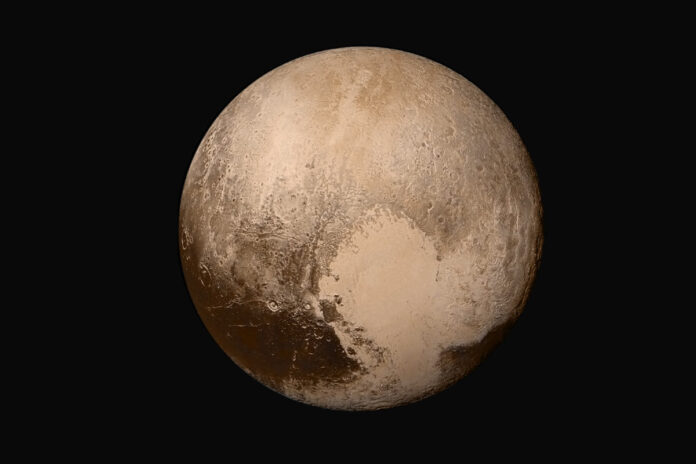
Pluto’s “Heart” – The Result of an Impact
Far away in our solar system on the surface of Pluto, there is a gigantic heart-shaped structure visible. Up until now, astronomers have been puzzled about how this unique form came to be. It now emerges that the explanation isn’t as sensational as initially thought: an inclined cosmic collision imprinted the icy dwarf planet with this symbol of love.
The Discovery of Pluto’s “Heart”
Ever since NASA’s New Horizons mission discovered the massive heart-shaped structure on Pluto in 2015, scientists have been intrigued, not just by the unique shape, but also by its composition and depth. They have been trying to crack the mystery behind Pluto’s most famous landmark, internally known as Sputnik Planitia, which forms the left lobe of the heart. They believe that it’s the outcome of a colossal but slow, oblique impact. In the early years of Pluto, a heavenly body about 700 kilometers in diameter likely had a massive collision with the dwarf planet. The discovery raises further questions regarding the speculated subsurface ocean on Pluto.
A Glittering Heart in the Darkness
The heart, also known as the Tombaugh Regio, captured not only the general public’s imagination due to its radiant material that reflects more light than its surroundings, making the area appear whiter. This region measures around 1200 by 2000 kilometers, approximately one-fourth the size of Europe, but astonishingly sits 3 to 4 kilometers lower than Pluto’s surrounding surface. According to Harry Ballantyne, the lead researcher from the University of Bern, “The brightness of Sputnik Planitia is because this depression is filled with white nitrogen ice that continually resurfaces to keep it smooth. The nitrogen likely gathered rapidly after the impact due to the lower elevation.”
Speculations about the Structure
The eastern lobe of the heart, too, is covered with a layer of nitrogen ice, albeit much thinner. Its origin is still unclear, but is likely also connected to Sputnik Planitia. The elongated shape of the affected area suggests that the impact was not head-on, but rather at an angle. Digital simulations were used to mimic the impact, varying both Pluto’s and the meteorite’s compositions, as well as the speed and the angle of the impact. The simulations corroborated the scientists’ speculations about the incline angle of the impact and also helped determine the composition of the heavenly body.
Cold Core Impact
“Pluto’s core is so cold that the rock stayed hard and did not melt due to the heat of the impact, and thanks to the angle of the impact and low speed, the core of the heavenly body did not sink into Pluto’s core but remained intact as a spot on top,” explained Ballantyne. The strength of the core and comparatively lower speed were crucial to the success of these simulations: less power would have resulted in a very symmetrical remnant, inconsistent with the tear shape observed by New Horizons.
Implications Beyond the Impact
The new study has unveiled more intriguing findings. Erick Asphaug, co-researcher from the University of Arizona, added, “We always think planetary collisions are very violent, where you can ignore the details except for energy, momentum, and density. But in the outer solar system, the speeds are much lower, and solid ice is strong. So, you need to be far more precise with your calculations.”
Conjecture About Subterranean Ocean
The new study tells us more than just the origins of Pluto’s “heart.” An impact of such magnitude likely occurred when Pluto was quite young. This interestingly provokes questions as the enormous depression should gradually move towards the dwarf planet’s pole due to its masslessness. Instead, it is near the equator. The prevalent theoretical explanation for this anomaly is that like other planets on the fringes of our solar system, Pluto has a liquid ocean under its icy crust. The crust is purportedly thinner in Sputnik Planitia’s region, allowing more of the ocean to bulge out, which leads to a surplus of mass resulting from water’s greater density than ice, thus instigating a migration towards the equator.
A New Explanation
However, the new study presents a different interpretation. “In our simulations, Pluto’s entire original mantle was excavated by the impact. If the core material from the impactor makes impressions on Pluto’s core, it creates a local surplus of mass that can explain the equatorial migration without a subsurface ocean, or at most a very thin one,” concluded one of the researchers.











